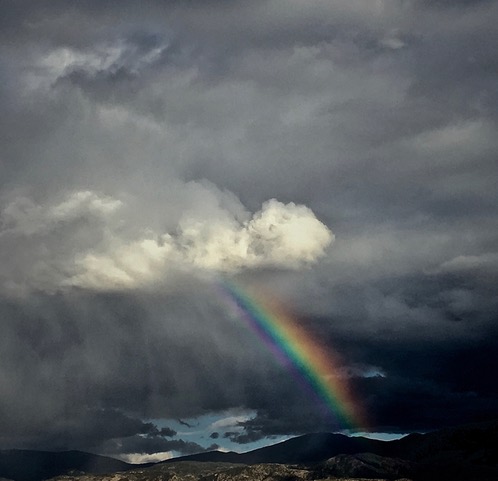Butterflying a Failed Essay

Now another of Montana’s state parks, Madison Buffalo Jump is a steeply skirted plateau capped with eroded limestone cliffs. On a blustery fall day in 2016, I visit Madison Buffalo Jump with classmates as part of a seminar
[Writers butcher memories]
in public history. Arriving at the small gravel parking lot, I am struck by the plateau’s monolithic
[they break them down,]
proportions. We leave the lot and head uphill, stopping at the small interpretative site—four panel displays under an open-walled pavilion—where we examine
[reflect and rework,]
[cut and insert,]
Madison’s past stitched together and displayed by Montana Fish, Wildlife, and Parks.
[and research.]
Native Americans harnessed quirks of local geology and topography to kill bison in astonishing numbers. Reading through the on-site panels and later poring over archaeological articles and dissertations, [We]
[imagine] in Madison Buffalo Jump a prehistoric ancestor to Chicago’s early 20th century processing districts.
The plateau was a holding pen, where panicked bison were funneled together by human runners and stone cairns into a tightening wedge. Eyes rolling and hooves pounding, an individual bison’s momentum and herd instinct carried it to a violent death over the cliff edge. If the forty-foot drop did not kill it, then the roll down the hillside shattered its bones and tore veins and tissue to shreds, leaving it bloody fodder for the stone cleavers and clubs carried by humans waiting down slope. Imagine this death dozens of times over, lives smashed like cars in a freeway pileup, and you begin to see an industrial scale [drama.]
take form. The ensuing slaughterhouse occurred beneath an open sky. Human muscles and hands twisted and cut away at leg joints, sliced and carried off nutrient-rich livers and tongues, and smashed skulls open to scoop out brain matter. [Laborious work,]
certainly, and [demanding on the butchers’ bodies and tools, but]
local chert deposits ensured steady supplies of cutters and scrapers to speed processing bone, fat, muscle, and hide. [there was] an ecological [algebra at work in the slaughter:]
organic energy transferred, subtracted, added, as bodies are broken, shattered, processed—and consumed. Environmental historian Mark Fiege reminds us that [all history is derived through this mathematics]—it seems to me that so, too, must all places [and stories, even though the equations undergirding their calculation are largely invisible to the beholding eye].
Material [fragments whisper these stories to me].
***
Writers butcher memories, they break them down, examine, reflect and rework, cut and insert, and research. We imagine drama. Laborious work, demanding on the butchers’ bodies and tools, but there is algebra at work in the slaughter: all history is derived through this mathematics, and stories, even though the equations undergirding their calculation are largely invisible to the beholding eye. Fragments whisper these stories to me.
***
Now another of Montana’s state parks, Madison Buffalo Jump is a steeply skirted plateau capped with eroded limestone cliffs. On a blustery fall day in 2016, I visit Madison Buffalo Jump with classmates as part of a seminar in public history. Arriving at the small gravel parking lot, I am struck by the plateau’s monolithic proportions. We leave the lot and head uphill, stopping at the small interpretative site—four panel displays under an open-walled pavilion—where we examine Madison’s past stitched together and displayed by Montana Fish, Wildlife, and Parks.
Native Americans harnessed quirks of local geology and topography to kill bison in astonishing numbers (Bachman 2016). Reading through the on-site panels and later poring over archaeological articles and dissertations, we imagine in Madison Buffalo Jump a prehistoric ancestor to Chicago’s early 20th century processing districts.
The plateau was a holding pen, where panicked bison were funneled together by human runners and stone cairns into a tightening wedge. Eyes rolling and hooves pounding, an individual bison’s momentum and herd instinct carried it to a violent death over the cliff edge. If the forty-foot drop did not kill it, then the roll down the hillside shattered its bones and tore veins and tissue to shreds, leaving it bloody fodder for the stone cleavers and clubs carried by humans waiting down slope. Imagine this death dozens of times over, lives smashed like cars in a freeway pileup, and you begin to see an industrial scale drama take form. The ensuing slaughterhouse occurred beneath an open sky. Human muscles and hands twisted and cut away at leg joints, sliced and carried off nutrient-rich livers and tongues, and smashed skulls open to scoop out brain matter. Laborious work, certainly, and demanding on the butchers’ bodies and tools, but local chert deposits ensured steady supplies of cutters and scrapers to speed processing bone, fat, muscle, and hide. There was an ecological algebra at work in the slaughter: organic energy transferred, subtracted, added, as bodies are broken, shattered, processed—and consumed. Environmental historian Mark Fiege (2012) reminds us that all history is derived through this mathematics—it seems to me that so, too, must places, even though the equations undergirding their calculation is largely invisible to the beholding eye.
Material fragments whisper these stories to me.
Works Cited
Bachman, Brandon J., “Class III Archaeological Survey Report: Madison Buffalo Jump State
Park, Gallatin County, Montana” (2016).
Graduate Student Theses, Dissertations, & Professional Papers. 10674.
Fiege, Mark. 2012. Republic of Nature: An Environmental History of the United States. Seattle:
University of Washington Press.
***
these stories
Rob Briwa is a graduate student at Montana State University’s Department of Earth Sciences. He is a cultural and historical geographer with broad interests in cultural landscapes, the American West, and the intersections of creative literature and place. He has published peer-reviewed scholarship in Literary Geographies and flash fiction in appearing in Montana Mouthful.